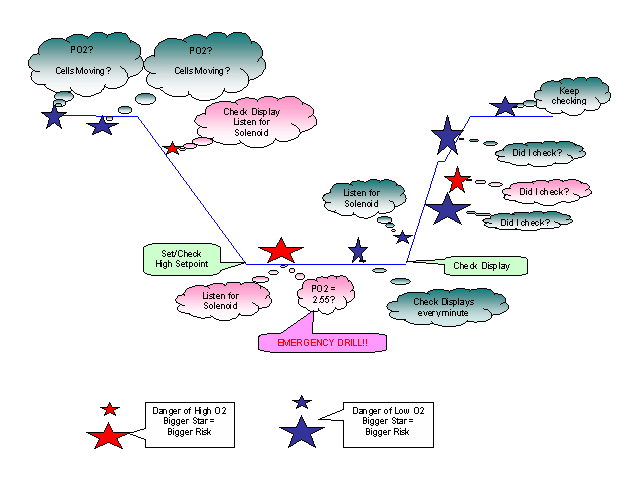
|
Rebreather Training is learning something |
The Statement above is something you should keep in mind then you think about rebreather-diving.
Some Examples:
So you see, being an experienced OC-Scuba-Diver who is new to Rebreather-Diving means taking care of not doing the same dives as would be possible for you on OC-Scuba. If you are new in something it needs to be done carefully and on the beginner-level.
The Picture above (courtesy Lyn Weller) shows some of the checks you have to do while "flying" an electronic controlled rebreather.
Real-world rebreather users:
>Learning how to successfully diving a CCR can't be any more
>difficult than learning
>how to successfully flying a small aircraft, and people do the
>latter all the time. In the case of aviation, however, people
>treat the machines and the training thereon with a great deal of
>respect (aided, of course, by the enforcement of the FAA).
>The problem with rebreathers is that recreational scuba training is
>NOT treated with anywhere near as much respect as flying.
I like your analogy. I would take it a bit further. OC is like hang gliding. Cruise around see the sights have fun and try a few tricks to increase the flight time. Nitrox like a sailplane. All the mechanical advantage you can get to increase flight time but you still need updrafts. Mixed gas like a private plane. Hey, we got some power now we can fly about as long as we want now. SCR like jets. WOW, we got real power here we go as far and as fast as we want now. And CCR like jets in CAT 3 weather ( if you stuck your arm out the window you couldn't see your fingertips). We can go anywhere we want anytime we want, but, if we don't read the instruments right we end up in the side of a mountain. The arguments I see around here sound just like the ones about those pilot killing whirlybirds. Most early test pilots crashed and many were killed. However if you asked one of the many people who have ridden in a helicopter they will tell you that they are very glad no one gave up on the idea before their 'Flight For Life' helo was built. The fact is that when human life depends on highly technical machines the earliest of those machines fail or the earliest users fail to operate them properly. In either case the cost is human life. If we learn from those failures and mistakes we can eventually find designs and methods which are safe. From what I have read I think the designs could be improved some but the real weak link is the training. Those of us looking for it don't know what we need, and those who know what we need don't think we will sit still for the whole thing.
Since I have decided to vent I will also give air to my feelings about electronics. Guess what I am an electronics tech. I work on aircraft instruments and avionics. I feel that water and electronics are a bad mix. So don't mix them. Keep them in separate compartments. Today's aircraft fly through thunder storms. Guess what is in thunder storms. Did I here you say lightning? Your right!! Millions of volts of electricity all arcing and sparking. This is what I call a hostile environment for electronics. Over the course of its life an aircraft may be struck several times by lightning, causing any number of system failures each time. Yet the aircraft and passengers survive. Why? Because due to the many times when the aircraft and passengers didn't survive we learned what doesn't work and eventually what does work. How? We studied and learned from the errors of the past and corrected them on the future designs and plans. Aircraft still crash and people still die, but many fewer than before. Did I here someone say "but is the electronics controlling the plane?" I think I did, and the answer is, yes. The current crop of airliners are 'fly by wire'. Which means that when the pilot moves his control yoke he requests that the computer do something. The computer then decides if it thinks the manoeuvre is ok. If it says yes the control surface moves. If it says no, the control surface does not. The pilot has no direct way of moving the control surface. He is at the mercy of the computer. Guess where these planes fly. Right, you guessed it, through the same thunder storms as all the others. How do they survive? They have highly redundant systems. That is the key. It's that simple, and that complex.
Jim and Rich know what they are talking about, so beware of thinking:
"I am an experienced OC-SCUBA-Diver, I only need a short explanation and than I can instantly do the coolest dives on that pretty toy."
Instead of searching for the cheapest, fastest shortcut into Rebreather-SCUBA-Diving, I would recommend you join at least a one-week class, and then work on your training to reach the advanced level and do the advanced test.
Dive safe, accept your limits, you might not have 7 lives left.
http://Rebreather.de/rebreather/training.htm © Karl Kramer, 20.10.1998